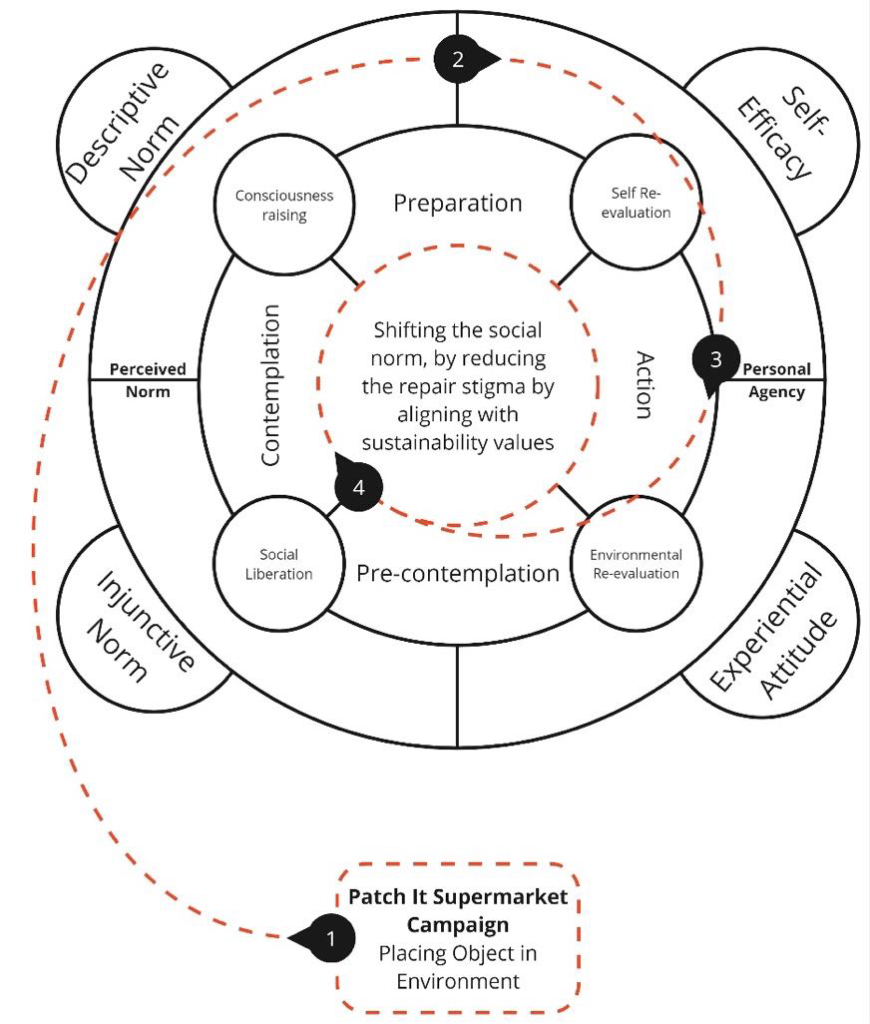Design for Behavioral Change
The Design for Behavioral Change course aimed to provide students with the knowledge and skills to design technologies that facilitate behavior change in a non-coercive and ethical manner. The course emphasized the integration of theory into the design of interactive systems aimed at fostering sustainable behavioral shifts. The course was structured into two main components:
- Theoretical Knowledge: Students were introduced to various behavioral change theories through lectures and self-study. The six core theories explored were:
- Theory of Planned Behavior (TPB): Explains how individual intentions lead to behavior, factoring in attitudes, subjective norms, and perceived behavioral control.
- Trans-Theoretical Model (TTM): Focuses on stages of change, such as pre-contemplation, contemplation, and action, guiding individuals through a process of adopting new behaviors.
- Elaboration Likelihood Model (ELM): Explores how people process persuasive information through central or peripheral routes.
- Self-Determination Theory (SDT): Centers on intrinsic motivation, autonomy, and competence, essential for long-term behavior change.
- Goal-Setting Theory: Examines how setting specific, achievable goals can drive behavior.
- Habit Theory: Explores how habits form and how they can be changed through deliberate interventions.
- Design Frameworks:
- Behavior Change Wheel (BCW): A comprehensive model for designing behavior change interventions that integrates theories with practical design strategies.
- COM-B Model: A central element of the BCW, which focuses on Capability, Opportunity, and Motivation as essential conditions for behavior change.
- Persuasive Systems Design (PSD): Offers a structured approach to designing interactive systems that encourage behavior change.
- Design with Intent: A set of design patterns used to influence behavior subtly.
Course Structure
The course was divided into several phases:
- Lectures and Theories: Early lectures introduced the core theories and frameworks. This knowledge was assessed through a mid-term written test.
- Workshops: Practical sessions helped teams apply the theories to real-world behavior change challenges, fostering a deep understanding of how to implement theoretical knowledge into design.
- Team Project: Each team worked on a design case, culminating in a group report that integrated their design rationale, theoretical foundation, ethical analysis, and evaluation plan.
Group Project: Reducing the Stigma on Repaired Clothing
Our team project focused on reducing the stigma associated with wearing repaired clothing, especially among fathers. This effort aligned with several sustainability goals, particularly those addressing fast consumerism in the fashion industry.
Problem Context: Fast fashion contributes significantly to environmental degradation, and many clothes are discarded due to minor wear and tear. We aimed to encourage fathers to repair and wear clothing, shifting societal norms toward sustainable clothing practices.
Design Concept: We developed a two-part intervention:
- The Patch-It Supermarket Campaign: A campaign promoting the repair of clothing, which leveraged male role models to normalize the behavior of wearing mended clothes in public.
- The Thick Thread Toolkit: A DIY repair kit designed to engage children in clothing repair, with the aim of encouraging their parents, especially fathers, to join in. The toolkit included child-friendly needles, colorful patches, and a “tips & tricks” card deck to make the experience fun and family-oriented.
Theoretical Rationale:
- We applied Self-Determination Theory (SDT) to address intrinsic motivation. Repairing clothes not only fosters autonomy but also builds competence as parents and children learn a valuable skill.
- The Transtheoretical Model (TTM) guided our intervention strategy, helping fathers move from pre-contemplation (unawareness of the need to repair) to action (actively repairing and wearing the clothing).
- COM-B analysis was used to identify key barriers to behavior change, particularly addressing the stigma (social opportunity) and lack of skills (psychological capability).
Ethics and Evaluation: We conducted a thorough ethical analysis, ensuring that our design avoided manipulative strategies, particularly toward children. We aimed to foster autonomy and sustainability while addressing potential conflicts such as accessibility for low-income families. Our evaluation plan focused on measuring changes in key determinants like subjective norms and self-efficacy among fathers.

Key Learnings
Through the project, we learned the importance of:
- Integrating Theory with Design: Applying behavioral change theories, like SDT and TTM, helped us design an intervention that was theoretically sound and actionable.
- Addressing Societal Stigma: Tackling social norms requires careful consideration of how behaviors are modeled and normalized in public spaces.
- Ethical Design: Ensuring that the intervention was both effective and ethically responsible was crucial, especially when targeting vulnerable groups like children and their families.
In summary, the Design for Behavioral Change course provided a rich blend of theory and practical design experience, equipping us with the skills to create sustainable and ethical behavior change interventions.